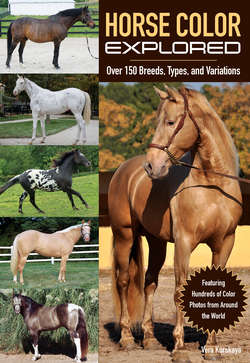Читать книгу Horse Economics - Vera Kurskaya - Страница 40
На сайте Литреса книга снята с продажи.
Silver Black and Silver Dapple
ОглавлениеThere aren’t well-established English terms designated to represent colors determined by the Silver gene on a black base. It is challenging to divide Silvery black color depending on the degree of dilution, because there are diverse phenotypes depending on the degree of Silver expression. Silver black is often a sepia color, usually combined with dapples (Photos 55–59). The guard hair can be from dark brown to light gray or white. Dark silver black horses have a black or dark chocolate colored body, and the mane and tail can have a dark yellow color due to the presence of black hair, or sometimes can also be very white. They can be mistaken for dark flaxen chestnuts. Silver black with an almost undiluted body and no dapples is also called silver chocolate by some.
This color is characteristic in Rocky Mountain Horses, and according to the Rocky Mountain Horse Association (www.rmhorse.com) it is called chocolate. The color is traced to the founding stallion of this breed: “Old Tobe.” Today more than 40 percent of Rocky Mountain Horses have the color.
The strongest dilution of the Silver gene results in silver dapple, which may remotely resemble dappled gray (Photo 60 and see p. 41). Silver dapple horses may also have a sepia shade, which is most common in Shetland Ponies and American Miniature Horses.
Distinguishing silver dapple horses from gray horses with dapples is simple: the head of a silver horse is either darker than the body or the same color. The head of a gray horse is always lighter. You should also look for other traits we discussed on p. 27, such as light eyelashes and leg webbing. White or light eyelashes are found most often in silver black or silver dapple horses.
American Miniature Horses carrying the Silver gene on the black base are often erroneously registered as having the gray, chestnut, or even palomino color. Silver dapple foals with a black base are born rosy cream, light ashy, or the color of a light biscuit, vaguely resembling palominos with gray muzzles. Dapples are absent at this age. The tail and mane of silver black and silver dapple horses sometimes darken with age. In the winter they become browner and dapples disappear.
